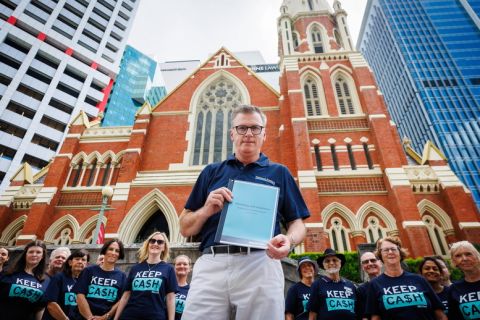Electricity price shock – compare your plans
Struggling with high energy prices? Call your energy company and ask about a cheaper plan. Here’s how.

Cash-back offer on appliances for Queenslanders
The Queensland Government has launched a cash-back program encouraging consumers to purchase energy-efficient appliances.
Acting Premier Steven Miles said the new Climate Smart Energy Savers program offers between $300 and $1,000 cash back on a range of eligible energy-efficient appliances.
Funding is limited and is granted on a first come, first serve basis until funds are exhausted.
Low-income earners who earn a taxable income of $66,667 or less are able to claim the most, but all Queenslanders will be eligible to access cost-of-living support on selected appliances.
Details on how to apply are here.
The government's safety net price for electricity is there to protect the consumer, and you should not be paying more than it.
Households are being urged to contact their energy company and ask for cheaper electricity plans and not just put up with the plan they are currently on. And you don’t have to switch to another provider to save.
Energy companies offer a variety of plans, some of which could offer better value given recent price increases of 10% to 20% above the regulated safety net (more on that later).
Energy companies are required to provide certain information in bills and letters to help you compare your current energy plan to other available plans. It’s important to look at your bill and any letters or emails they send you. Check any recent communications for price increases.
Your current energy plan will most likely be what’s called a “market offer”. This is what 90% of households are on.
Market offers are the tailored plans that energy companies advertise to attract customers. They can include discounts and different tariffs depending on people’s circumstances. They are also available to existing customers.
State-by-state energy rebate guide
National Seniors Australia Chief Advocate Ian Henschke has recorded a series of videos explaining the energy bill concessions available to seniors across the country.
Click here to view the video relevant to your state or territory.
But there is also a government electricity price safety net price available through a type of energy plan known as the Default Market Offer (DMO) in New South Wales, South East Queensland, and South Australia or the Victorian Default Offer (VDO) in Victoria.
The DMO was designed to protect disengaged consumers. It establishes pricing rules that limit how much companies can charge customers on these plans, which are called standing offer contracts.
Every retailer must offer their customers what’s called a “standing offer contract” that is no higher than the DMO/VDO.
But energy companies are not obliged to move customers onto it when they increase the price of an existing market offer contract higher than the safety net.
“We know that many Australians are likely paying more for electricity than they need to because their recently increased rates are higher than the safety net built into standing offer contracts,” ACCC Commissioner Anna Brakey said.
“We are seeing evidence of a significant reversal in the role of the safety net price, which was designed as a maximum price to protect disengaged consumers but is becoming a cheaper option for many people.
“You don’t necessarily need to change energy company to get a better deal: the simplest thing you can do is to contact your existing company and ask how your current plan compares to the regulated standing offer,” Ms Brakey said.
Recent letters seen by the ACCC from energy companies to residential customers include the following information about price increases:
These new rates are 21% above the DMO reference price, however, can be 4% above the DMO reference price if you pay on time.
This Energy Plan is 19% more than the reference price.
Due to the variation in our rates from 1 July 2023, your plan will be 9% greater than the reference price.
An average household on a market plan that is now 21% above the DMO reference price could save about $400 per year simply by moving to the regulated standing offer, assuming average consumption.
That same household could save about $600 per year if they moved onto a market offer which is 10% below the reference price, assuming average consumption.
The government safety net price for electricity is there to protect the consumer, and you should not be paying more than it.
ACCC analysis shows that 90% of currently advertised market offers are below the reference price.
There is also significant price variation between those market offers below the reference price, with some smaller retailers offering relatively large discounts.
“The case for switching to a different energy company is strong because the cheapest offers in the market appear to be reserved for new customers, rather than existing ones,” Ms Brakey said.
“We strongly encourage households and small businesses to use the Government comparison sites Energy Made Easy and Victorian Energy Compare to find a better offer.”
The ACCC’s website has been updated with information to help people find the best electricity deal. The best questions to ask your energy company are here.
To compare offers, go to Energy Made Easy, the free Government comparison site for customers in New South Wales, Queensland, South Australia, Tasmania and the Australian Capital Territory, which is operated by the Australian Energy Regulator.
Victorian customers should go to Victorian Energy Compare, the free comparison site operated by the Victorian Government.
Related reading: ACCC media release, ACCC consumer advice, AER








